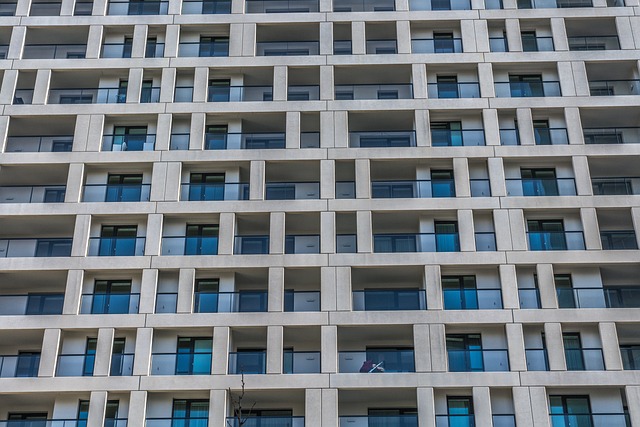Glulam (glue-laminated timber) is a revolutionary building material transforming modern architecture with its exceptional strength, versatility, and sustainability. By laminating multiple layers of wood, it creates dynamic structures that blend stunning aesthetics with structural integrity. Ideal for commercial buildings like offices and retail stores, glulam's innovative use challenges traditional methods, enhances user experiences, and reduces environmental impact. Its ability to accommodate complex geometry makes it a favorite among architects, while its renewability appeals to cultural centers and museums. Iconic structures like the Seattle Central Library showcase glulam's versatility, positioning it as a game-changer in global architecture and sustainable infrastructure.
“Discovering the future of architecture with Glulam: a revolutionary material transforming design. From structural innovation to sustainable practices, Glulam is unlocking new possibilities for modern construction. This article explores its versatility, from redefining space and promoting environmental sustainability to creating visually striking interiors. We delve into real-world applications, presenting case studies of iconic Glulam structures that have left an indelible mark on the industry. Uncover how this material is a game-changer in contemporary architecture.”
- Unlocking the Potential: Exploring Glulam's Versatility in Modern Design
- Structural Innovation: How Glulam is Redefining Space and Form
- Sustainability Focus: The Environmental Benefits of Glulam Architecture
- Aesthetic Appeal: Glulam's Role in Creating Stunning and Unique Interiors
- Glulam in Practice: Case Studies of Iconic Structures and Their Impact
Unlocking the Potential: Exploring Glulam's Versatility in Modern Design
The versatility of Glulam (glue-laminated timber) is unlocking new possibilities in modern architecture, allowing designers and builders to create structures that were once considered complex or impossible with traditional building materials. This innovative construction technique has proven itself as a game-changer in various sectors, particularly in commercial buildings. Glulam solutions for complex geometry offer an aesthetic appeal that blends seamlessly with contemporary design while providing exceptional structural integrity.
By employing glulam construction techniques, architects can craft dynamic forms and unique spaces that challenge conventional building methods. Its strength-to-weight ratio makes it a sustainable alternative to steel or concrete, reducing environmental impact while delivering superior performance. The range of glulam applications in commercial buildings is expanding, from sleek office spaces to striking retail stores and public landmarks, showcasing its adaptability and ability to enhance the overall user experience.
Structural Innovation: How Glulam is Redefining Space and Form
Glulam, short for glued-laminated timber, is revolutionizing modern architecture with its structural innovation and versatile design possibilities. This remarkable material combines multiple layers of wood laminates bonded together with strong adhesives, resulting in incredibly strong and stable structures. Architects are now able to create dramatic spatial experiences that would have been unattainable with traditional building methods.
The engineering marvels of glulam allow for unprecedented forms and dimensions, enabling the construction of dynamic curves, cantilevers, and complex geometries. This has led to the development of sustainable building materials glulam, as its use reduces the environmental impact compared to concrete or steel while offering exceptional structural integrity. The versatility of glulam in both residential and commercial projects showcases its potential to redefine space and form in contemporary architecture.
Sustainability Focus: The Environmental Benefits of Glulam Architecture
The construction industry is increasingly focusing on sustainability, and glulam architecture stands out as a promising solution for both environmental and structural integrity. Glulam, or glued laminated wood, is a modern wood product that combines multiple layers of wood lams to create incredibly strong and durable structures. This innovative material offers a range of benefits, including reduced environmental impact compared to traditional building materials.
Glulam’s production process involves high-quality forest resources, advanced bonding techniques, and precise manufacturing, resulting in superior performance. Its ability to handle complex geometry makes it an ideal choice for modern architectural designs. By using glulam, architects can create structures with minimal waste, as the material is engineered to utilize wood efficiently. This not only reduces the carbon footprint but also promotes a more sustainable approach to construction, aligning with the growing demand for eco-friendly glulam solutions in today’s market.
Aesthetic Appeal: Glulam's Role in Creating Stunning and Unique Interiors
Glulam, or glued laminated timber, has emerged as a powerful tool for architects and designers seeking to create stunning and unique interiors. Its aesthetic appeal lies in its ability to showcase the natural beauty of wood, offering a warm and inviting ambiance that is both visually captivating and tactilely pleasing. By layering thin strips of timber, glulam forms robust and elegant structural elements that can be shaped into intricate designs, from curved beams to complex geometric patterns. This versatility allows for the creation of striking architectural features, such as sweeping ceilings, dynamic wall paneling, and eye-catching staircases, transforming interior spaces into true works of art.
Furthermore, glulam’s role extends beyond structural integrity; it contributes to the overall sustainability and eco-friendliness of a space. As an renewable resource, wood has a lower environmental impact than traditional building materials, making glulam applications in cultural centers, museums, and other public spaces not only visually stunning but also responsible choices. Innovative glulam construction methods continue to push the boundaries of what’s possible, enabling architects to realize ambitious designs that blend aesthetics and functionality seamlessly.
Glulam in Practice: Case Studies of Iconic Structures and Their Impact
Glulam, or glued laminated timber, has left its mark on the architectural landscape with iconic structures worldwide. These buildings stand as testament to the material’s strength and versatility, showcasing glulam’s potential in both modern and historic designs. Case studies of notable glulam structures reveal their impact on urban spaces. For example, the Seattle Central Library features a vast glulam roof system, becoming an emblem of contemporary architecture that seamlessly blends aesthetics and structural integrity.
The success of glulam in these projects highlights its role in sustainable infrastructure. Glulam for sustainable construction offers environmental benefits, as it utilizes renewable resources and has a lower carbon footprint compared to traditional building materials. Furthermore, glulam structural integrity testing ensures the safety and longevity of these structures, providing engineers with reliable data to challenge conventional ideas about timber’s capabilities.
Glulam architecture is not just a trend—it’s a revolution. By harnessing the versatility, structural integrity, and environmental benefits of glulam, modern designers are unlocking new possibilities in space and form. From iconic structures to stunning interiors, glulam’s impact is undeniable. As we continue to prioritize sustainability and unique aesthetics, this innovative material will undoubtedly play a pivotal role in shaping the built environment for years to come.







